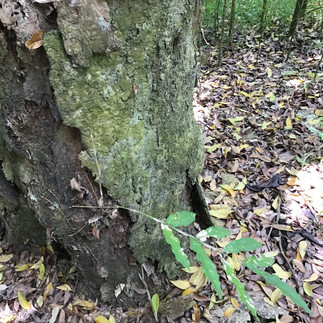
Some plants like to spread out and are found in many locations, while others are home-bodies and not found just anywhere. Manele (aka a’e or soapberry) is one of the latter. Manele is a large tree which makes its Hawai’i home only on the Big Island in three locations. One is on a section of the Mauna Loa Road (aka Strip Road) and the other is at Kipukapuaulu (aka Bird Park). The third location is on the slopes of Hualalai. Manele is native, though not endemic to Hawaii. It is also native to the Pacific and tropical and sub-tropical American continents. That’s a large region for a plant that won’t move from three spots on one island.
To clarify, or perhaps confuse, there is another a’e (aka manele). That one is endemic and is found only on Oahu and Kaua’i. It is a smaller tree and of a different species. It’s scientific name is Sapindus oahuensis. The manele found on the Big Island is Sapindus saponaria.
To locate manele, Sapindus saponaria, first look for a big tree with gray-brown bark that seems to be peeling off in large irregular sections. Then check the leaves. Manele has pairs of oblong leaflets. Since manele is deciduous, you may not always see the leaves, but if you find a large tree in manele’s favored areas growing high in the canopy among the usually dominant ‘ohi’a and koa, you have found manele.
Fun Facts: 1) A 71 foot manele in Kipukapuaulu was named to the National Register of Big Trees in 2017, 2) As a seedling, manele has an interesting form. It looks like a fern. A winged leaflet stem gives it this appearance.






Comments